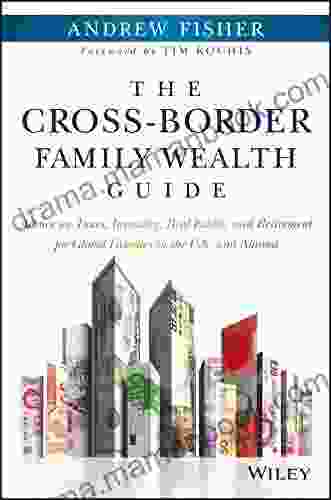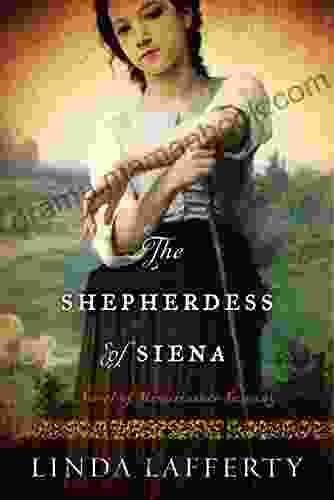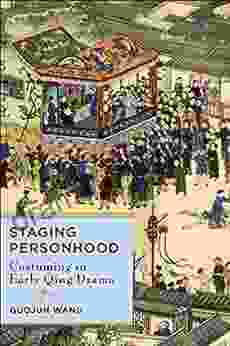Staging Personhood: Costume and Identity in Early Qing Drama

In the early Qing dynasty (1644-1911),costume played a vital role in shaping the identities of characters on stage. Costumes conveyed social status, rank, and gender, and they were also used to express the inner emotions and motivations of characters. In this article, we will explore the ways in which costumes were used to symbolize and shape the identities of characters in early Qing drama.
Costuming and Social Status
In early Qing drama, costumes were used to indicate the social status of characters. For example, the emperor would always wear a yellow robe, which was the color reserved for the emperor. Other high-ranking officials would wear robes of different colors, depending on their rank. Commoners, on the other hand, would wear simple clothes made of cotton or hemp.
5 out of 5
| Language | : | English |
| File size | : | 59596 KB |
| Text-to-Speech | : | Enabled |
| Screen Reader | : | Supported |
| Enhanced typesetting | : | Enabled |
| Print length | : | 307 pages |
| Paperback | : | 132 pages |
| Item Weight | : | 5.6 ounces |
| Dimensions | : | 5.85 x 0.33 x 8.27 inches |
Costumes also indicated the occupation of characters. For example, a scholar would wear a long robe with a square collar, while a soldier would wear a short robe with a round collar. Merchants would wear a long robe with a round collar and a hat, while farmers would wear a short robe with a square collar and a straw hat.
Costuming and Rank
In addition to social status, costumes were also used to indicate the rank of characters. For example, the emperor would wear a robe with nine dragons embroidered on it, while a prince would wear a robe with eight dragons. Other high-ranking officials would wear robes with a number of dragons corresponding to their rank.
Rank was also indicated by the color of the robe. For example, a first-rank official would wear a red robe, while a second-rank official would wear a purple robe. Third-rank officials would wear a blue robe, and fourth-rank officials would wear a green robe.Fifth-rank officials and below would wear robes of other colors.
Costuming and Gender
Costumes were also used to indicate the gender of characters. For example, men would wear robes, while women would wear skirts. Men's robes were typically longer than women's skirts, and they were often made of more expensive materials. Women's skirts were often shorter, and they were often made of less expensive materials.
In addition to the length and material of the clothing, there were other ways in which costumes were used to indicate gender. For example, men would often wear hats, while women would often wear hairpins. Men's hats were typically taller and more elaborate than women's hats, and they were often made of more expensive materials.
Costuming and Inner Emotions
In addition to conveying social status, rank, and gender, costumes were also used to express the inner emotions and motivations of characters. For example, a character who is angry might wear a red robe, while a character who is sad might wear a black robe. A character who is wealthy might wear a robe made of expensive materials, while a character who is poor might wear a robe made of cheap materials.
Costumes could also be used to indicate a character's personality. For example, a character who is brave might wear a robe with a dragon embroidered on it, while a character who is cowardly might wear a robe with a mouse embroidered on it. A character who is intelligent might wear a robe with a book embroidered on it, while a character who is foolish might wear a robe with a donkey embroidered on it.
In early Qing drama, costumes played a vital role in shaping the identities of characters. Costumes conveyed social status, rank, gender, and the inner emotions and motivations of characters. By carefully choosing the costumes for their characters, playwrights were able to create rich and complex characters that came to life on stage.
5 out of 5
| Language | : | English |
| File size | : | 59596 KB |
| Text-to-Speech | : | Enabled |
| Screen Reader | : | Supported |
| Enhanced typesetting | : | Enabled |
| Print length | : | 307 pages |
| Paperback | : | 132 pages |
| Item Weight | : | 5.6 ounces |
| Dimensions | : | 5.85 x 0.33 x 8.27 inches |
Do you want to contribute by writing guest posts on this blog?
Please contact us and send us a resume of previous articles that you have written.
 Top Book
Top Book Novel
Novel Fiction
Fiction Nonfiction
Nonfiction Literature
Literature Paperback
Paperback Hardcover
Hardcover E-book
E-book Audiobook
Audiobook Bestseller
Bestseller Classic
Classic Mystery
Mystery Thriller
Thriller Romance
Romance Fantasy
Fantasy Science Fiction
Science Fiction Biography
Biography Memoir
Memoir Autobiography
Autobiography Poetry
Poetry Drama
Drama Historical Fiction
Historical Fiction Self-help
Self-help Young Adult
Young Adult Childrens Books
Childrens Books Graphic Novel
Graphic Novel Anthology
Anthology Series
Series Encyclopedia
Encyclopedia Reference
Reference Guidebook
Guidebook Textbook
Textbook Workbook
Workbook Journal
Journal Diary
Diary Manuscript
Manuscript Folio
Folio Pulp Fiction
Pulp Fiction Short Stories
Short Stories Fairy Tales
Fairy Tales Fables
Fables Mythology
Mythology Philosophy
Philosophy Religion
Religion Spirituality
Spirituality Essays
Essays Critique
Critique Commentary
Commentary Glossary
Glossary Bibliography
Bibliography Index
Index Table of Contents
Table of Contents Preface
Preface Introduction
Introduction Foreword
Foreword Afterword
Afterword Appendices
Appendices Annotations
Annotations Footnotes
Footnotes Epilogue
Epilogue Prologue
Prologue Jeremy Peters
Jeremy Peters Sharon Garlough Brown
Sharon Garlough Brown Max Alina
Max Alina George Wallace
George Wallace Cassandra Erkens
Cassandra Erkens Keisuke Itagaki
Keisuke Itagaki Andrew Aziz
Andrew Aziz Thomas Lubben
Thomas Lubben Wendy Rae
Wendy Rae Nassim Nicholas Taleb
Nassim Nicholas Taleb Danielle White
Danielle White Vincent Bivona
Vincent Bivona Viki Winterton
Viki Winterton Augusto Lopez Claros
Augusto Lopez Claros Hemanta Sundaray
Hemanta Sundaray Rachel Hawkins
Rachel Hawkins Jennifer Jones
Jennifer Jones Blake J Harris
Blake J Harris Richard M Ankers
Richard M Ankers Sarah Mercer
Sarah Mercer
Light bulbAdvertise smarter! Our strategic ad space ensures maximum exposure. Reserve your spot today!

 Robert BrowningAdvice On Taxes, Investing, Real Estate, And Retirement For Global Families
Robert BrowningAdvice On Taxes, Investing, Real Estate, And Retirement For Global Families
 Braeden HayesSocial Skills Groups for Children and Adolescents with Asperger Syndrome: A...
Braeden HayesSocial Skills Groups for Children and Adolescents with Asperger Syndrome: A... Brenton CoxFollow ·5.3k
Brenton CoxFollow ·5.3k Herman MitchellFollow ·6.1k
Herman MitchellFollow ·6.1k Boris PasternakFollow ·11.3k
Boris PasternakFollow ·11.3k Kevin TurnerFollow ·7.4k
Kevin TurnerFollow ·7.4k Charles DickensFollow ·14.1k
Charles DickensFollow ·14.1k Jedidiah HayesFollow ·19.7k
Jedidiah HayesFollow ·19.7k Jack PowellFollow ·17.1k
Jack PowellFollow ·17.1k Avery SimmonsFollow ·3k
Avery SimmonsFollow ·3k

 Jesus Mitchell
Jesus MitchellThe Diabetics Menu: Your Low Carb Options
If you're living with diabetes, you may be...

 Danny Simmons
Danny SimmonsThe Sam Reilly Collection: A Treasure Trove of...
In the realm of...

 Vic Parker
Vic ParkerThe Shepherdess of Siena: The Extraordinary Life of Saint...
Catherine of Siena, known as the...

 Christian Carter
Christian CarterDive into the Mystical World of Meraki Syren: A Literary...
A Literary Odyssey Through the Depths...

 Eric Hayes
Eric HayesSimplest Method on How to Remove Credit Cards from Your...
Do you have multiple credit cards...
5 out of 5
| Language | : | English |
| File size | : | 59596 KB |
| Text-to-Speech | : | Enabled |
| Screen Reader | : | Supported |
| Enhanced typesetting | : | Enabled |
| Print length | : | 307 pages |
| Paperback | : | 132 pages |
| Item Weight | : | 5.6 ounces |
| Dimensions | : | 5.85 x 0.33 x 8.27 inches |










